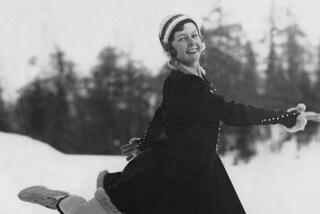Destination: Colorado : City of Olympic Tributes : But Harding Scandal Ironic Footnote at Skating Museum
COLORADO SPRINGS, Colo. — The costume is unremarkable by figure-skating standards: a long-sleeved, conservatively beaded light-aqua dress with a short skirt cut to resemble the petals of a flower. But it represents a most remarkable moment in figure-skating history: It was the costume worn by Tonya Harding at the 1991 United States National Figure Skating Championships, when she became the first U.S. woman ever to perform a triple-axel jump in competition.
As I stood last summer before the case displaying that costume, at the World Figure Skating Museum and Hall of Fame in Colorado Springs, I could never have imagined that the woman who wore it would soon become the center of a scandal that has turned world attention on the sport.
The museum contains nothing of her rival Nancy Kerrigan, whom Harding will duel for Olympic gold this Wednesday and Friday. Kerrigan, of course, is the 1992 Olympic bronze medalist who was whacked in the knee at this year’s National Championships in Detroit in a plot Harding’s former husband has admitted to masterminding along with, he alleges, Harding herself. With the media frenzy that the Kerrigan attack has produced, not only die-hard figure-skating fans like myself but people who previously did not know a triple axel from a car axle might find some fascination with this museum.
And, for those caught up in the Olympic spirit after watching the Winter Games in Lillehammer, Norway, the skating museum is only one of a number of sporting sites to see here.
Sponsored by the United States Figure Skating Assn., the sport’s governing body, and located on two floors at USFSA headquarters, the museum may be the only institution in the world devoted exclusively to all aspects of the sport.
For skating fans, the museum is an “ooh and ah” kind of place. But even visitors not interested in skating may be intrigued. There is interesting history in the museum’s Skate Gallery where, for example, skates made of cow and sheep bones, dating back to the 8th Century, are on view. The World and United States Hall of Fame galleries, with their trophies and photographic plaques, detail the accomplishments of skating greats.
Also on display are more than 20 versions of “Hans Brinker and the Silver Skates,” perhaps the best-known skating story in the world, along with an assortment of other novels, magazines and show programs. A video plays skating highlights from ABC continuously.
The art exhibits begin with a life-size bronze sculpture of Britain’s Patricia Dodd, former star of the John Curry Skating Co., at the entrance. It was donated by its sculptor, Stanley Taub, but the bulk of the artwork on display is from the “Skating in Art” collection of Swedish skater Gillis Grafstrom, a 1920s Olympic champion.
Grafstrom’s extensive assemblage of skating-related art, figurines, porcelain, silver, crystal, antique skates and other historical items is exhibited throughout the museum. Among older holdings are a calendar print, circa 1580, and a 1784 copper engraving of a Massachusetts River ice sports scene.
Several of the world’s most renowned skaters merit their own sections, with photos and memorabilia. One is Brian Boitano, the 1988 Olympic champion from Northern California who returned to amateur competition this season after six years as a professional. He came in second at the U.S. Nationals in January, and on Saturday was scheduled to make his second bid for Olympic gold. On display is a mannequin bearing the costume, a scarlet and blue military-style outfit, that Boitano wore at the 1988 games.
A tribute to 1984 Olympic gold medal winner Scott Hamilton features his Olympic and World Championship medals, red-and-blue Olympic skating costume, Olympic team member certificate, a Senate citation and trophies won as an amateur and a professional.
Three-time Olympic champion, Norwegian skater Sonja Henie, who won movie stardom in the late 1930s and ‘40s, is represented in a display of Madame Alexander dolls that more closely resemble Shirley Temple. And there are photos galore, plus Henie’s last pair of skates and final exhibition costume.
For me, the highlight of the museum was the costumes, beginning with Boitano’s. Other favorites were the navy-blue attire of surprise 1992 Olympic silver medalist Paul Wylie, the striking black-and-red “Carmen” dress worn by Debi Thomas when she won the 1988 Olympic bronze, and the simple, powder-blue, rainbow-themed exhibition outfits of Los Angeles’ 1979 World Champions, Tai Babilonia and Randy Gardner.
In sharp contrast to these happy reminders, one exhibit brought tears. It was the tribute to the 1961 World Figure Skating Team, whose members, along with coaches, officials, family and friends, died in a plane crash in Brussels en route to the World Championships in Prague. Four were Los Angeles-area skaters. Photos, medals and costumes pay tribute to promises unfulfilled, and a memorial book contains expressions of sympathy from skaters and devotees around the world, beginning with President John F. Kennedy.
The museum also hosts changing special exhibits, such as the one on view through March: a collection tracing Olympic figure skating from 1908, when the sport was introduced during the Summer Games in London. Another exhibit, featuring the work of well-known skating photographer Paul Harvath, continues through August.
The museum may have been a figure-skating mecca for me, but it was just the first stop on my pilgrimage. From there, I took the 10-minute walk south to the Broadmoor Hotel to check out the skating at the legendary Broadmoor World Arena. And not a moment too soon: The venerable rink has been the site of six previous U.S. and five World Championship events, and the 1994 World Junior Championships held last December. It was also the training home of 1968 Olympic champion Peggy Fleming. Sadly, the historic rink will close March 15 for demolition to make way for a new addition to the resort hotel.
Inside, the legacy of more than 50 years of competitions and training sessions was almost palpable. Practicing on this particular July day were 1994 Olympic contender and 1993 and ’94 U.S. men’s champion Scott Davis, who regularly trains here, and this year’s Olympic silver medalists, pair skaters Natalia Mishkutienok and Artur Dmitriev of Russia.
Figure skating isn’t the only sport celebrated here. The city, is, after all, the site of the largest of three U.S. Olympic training centers, which, in turn, house the U.S. Olympic Committee, the governing body for the Olympic and Pan American Games.
Established in 1978 at the behest of then-President Gerald Ford, who was dismayed by U.S. athletes’ poor showing at the 1976 Olympics, the center hosts about 17,000 athletes per year, usually for one or two weeks. I took a one-hour tour of the 36-acre complex, formerly a U.S. Air Force base and NORAD headquarters.
Inside, even I, who despise boxing, was impressed by the pageantry of the brightly colored boxing rings, with their bags and mirrors for shadow boxing.
Through a glass wall adjoining the boxing area, I could see a large gymnasium, complete with television lighting, which can be divided into three gyms for any of 13 Olympic events, including gymnastics, volleyball and basketball.
Our next stop was the Shooting Center, which claims to be the largest indoor gun-shooting facility in the Western Hemisphere. In the lobby were shooting-related artworks, among them a bronze sculpture of an arrow-toting goddess, and a Korean crown--trophies from national competitions. We learned the finer points of the sport while observing junior-level shooters wearing jackets and gloves, we were told, to muffle their heartbeats so they would not be distracted by the sound.
The tour ends at the gift shop, jampacked with Olympic-logo merchandise, with proceeds benefiting athletes. Each tour participant receives a glossy, photo-laden book detailing Olympic history.
I had planned the Olympic Training Center as the end of my sports trek, but I was mistaken. At the summit of 14,110-foot Pikes Peak, just outside the city, I discovered a granite monument erected by the U.S. Olympic Committee with the names of all Olympic athletes who have trained in Colorado Springs. Seeing this tribute, set against the vistas that in 1893 had inspired Katherine Lee Bates to write the lyrics to “America the Beautiful,” proved a truly grand finale to my pilgrimage.
GUIDEBOOK: An Ice Time in Colorado
Getting there: Several airlines offer direct or connecting (but no nonstop) service to Colorado Springs. Morris Air has the least-expensive, advance-purchase round-trip fare: $178. America West, Continental, United and Delta also fly there.
Where to stay: Numerous accommodations are available, from the deluxe to cabins and hostels. The ultimate is the Broadmoor, an elegant resort with its own lake set against a mountain backdrop. Double occupancy rates now through April 30, $145-$1,275; May 1-Oct. 1, $225-$1,800. (1 Lake Circle or P.O. Box 1439, Colorado Springs 80901, tel. 800-634-7711). Bed and breakfasts include the Victorian-style Hearthstone Inn, $78-$140 double (506 N. Cascade Ave., Colorado Springs 80903, tel. 800-521-1885 or 719-473-4413.)
What to do: The World Figure Skating Museum and Hall of Fame is open year-round Monday through Friday, the first Saturday of each month and every Saturday June through August, 10 a.m.-4 p.m. Admission is free. (20 First St., Colorado Springs 80906, tel. 719-635-5200.)
Free tours of the Olympic Training Center are held hourly in winter, Monday through Saturday 9 a.m.-4 p.m., Sunday noon-4 p.m.; and half-hourly in summer, Monday through Saturday 9 a.m.-5 p.m., Sunday 10 a.m.-4 p.m. (1750 E. Boulder St., Colorado Springs 80909, tel. 719-632-5551.)
The Pikes Peak Cog Railway departs from the nearby town of Manitou Springs, April 23 through Oct. 30. Prices: Adults $21, children $9.50. (Reservations recommended, P.O. Box 351, Manitou Springs 80829, 719-685-5401.) Gray Line offers a bus tour to Pikes Peak’s summit three times a day from May through October, for $20 a person. (3704 W. Colorado Ave., Colorado Springs 80904, tel. 719-633-1181.)
For more information: Contact the Colorado Springs Convention and Visitors Bureau, 104 S. Cascade, Suite 104, Colorado Springs, Colo. 80903; tel. (800) 368-4748 or (719) 635-7506.
More to Read
Go beyond the scoreboard
Get the latest on L.A.'s teams in the daily Sports Report newsletter.
You may occasionally receive promotional content from the Los Angeles Times.






